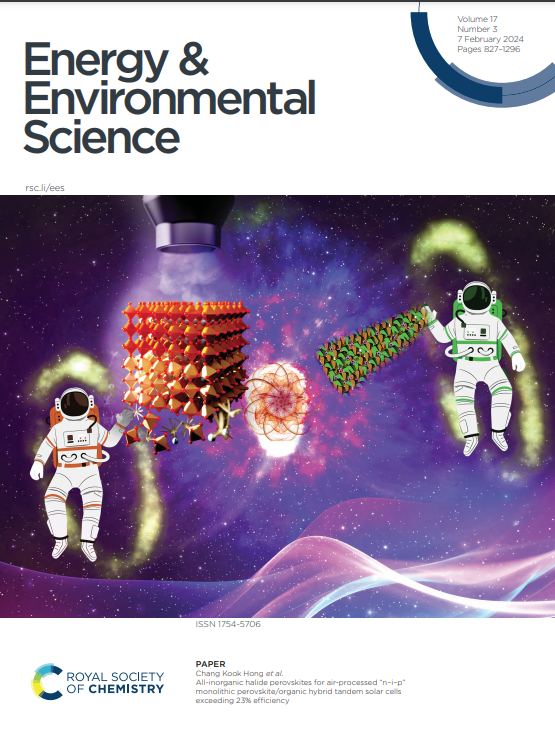Bioinspired Electrocatalyst for CO2 Electroreduction to Ethanol via Secondary-Sphere Synergy in Fe Porphyrinic-Based Metal-Organic Frameworks
IF 32.4
1区 材料科学
Q1 CHEMISTRY, MULTIDISCIPLINARY
引用次数: 0
Abstract
Carbon dioxide electroreduction reaction (CO2RR) to ethanol (C2H5OH) represents a sustainable route toward carbon neutrality. Herein, we present the design of enzyme-inspired zirconium-Fe porphyrinic-based metal-organic framework (MOF) nanosheets functionalized with 5-benzimidazolecarboxylic acid (FeTCPP-NSs-BAA) for CO2RR. Electrochemical performances in H-cell reveal that FeTCPP-NSs-BAA achieves C2H5OH Faradaic efficiencies (FEs) of 79.8% under neutral and 89.2% under acidic conditions, with C2H5OH FEs exceeding 60% over wide potential windows of –0.3 to –0.6 V and –0.3 to –0.8 V, respectively. In flow cell tests under acidic conditions, FeTCPP-NSs-BAA delivers a highest C2H5OH partial current density of 8.1 mA cm–2 with pure CO2, and a C2H5OH partial current density of 5.6 mA cm–2 when using 30% low-concentration CO2. Operando spectroscopic characterizations and theoretical calculations reveal that the superior C2H5OH performance of FeTCPP-NSs-BAA arises from the enzyme-like non-covalent synergistic effects between FeTCPP and the secondary-sphere functionalities of BAA and Zr6 clusters. Specifically, BAA enhances CO2 enrichment and facilitates the formation of tilted *CO adsorption at Fe centers on FeTCPP, which significantly reduces energy barriers for *CO-CO coupling compared to linearly adsorbed *CO. Meanwhile, the subsequent hydrogenation of *CO-CO to C2H5OH can be further accelerated by proton shuttling mediated through hydrogen-bonding networks introduced by Zr6 clusters.基于Fe卟啉金属-有机框架的二次球协同作用的CO2电还原制乙醇的仿生电催化剂
二氧化碳电还原反应(CO2RR)到乙醇(C2H5OH)是实现碳中和的可持续途径。在此,我们设计了以5-苯并咪唑羧酸(FeTCPP-NSs-BAA)功能化CO2RR的酶激发锆-铁卟啉基金属有机框架(MOF)纳米片。在h电池中的电化学性能表明,FeTCPP-NSs-BAA在中性条件下的C2H5OH法拉第效率(FEs)为79.8%,在酸性条件下为89.2%,在-0.3 ~ -0.6 V和-0.3 ~ -0.8 V宽电位窗口内,C2H5OH FEs分别超过60%。在酸性条件下的流动电池测试中,FeTCPP-NSs-BAA在纯CO2条件下提供了最高的C2H5OH分电流密度8.1 mA cm-2,在30%低浓度CO2条件下提供了5.6 mA cm-2的C2H5OH分电流密度。Operando光谱表征和理论计算表明,FeTCPP- nss -BAA优异的C2H5OH性能源于FeTCPP与BAA和Zr6簇的二级球官能团之间的酶样非共价协同作用。具体来说,BAA增强了CO2的富集,有利于fecpp上Fe中心形成倾斜的*CO吸附,与线性吸附的*CO相比,显著降低了*CO-CO耦合的能垒。同时,Zr6团簇引入的氢键网络介导的质子穿梭可以进一步加速*CO-CO随后加氢生成C2H5OH。
本文章由计算机程序翻译,如有差异,请以英文原文为准。
求助全文
约1分钟内获得全文
求助全文
来源期刊

Energy & Environmental Science
化学-工程:化工
CiteScore
50.50
自引率
2.20%
发文量
349
审稿时长
2.2 months
期刊介绍:
Energy & Environmental Science, a peer-reviewed scientific journal, publishes original research and review articles covering interdisciplinary topics in the (bio)chemical and (bio)physical sciences, as well as chemical engineering disciplines. Published monthly by the Royal Society of Chemistry (RSC), a not-for-profit publisher, Energy & Environmental Science is recognized as a leading journal. It boasts an impressive impact factor of 8.500 as of 2009, ranking 8th among 140 journals in the category "Chemistry, Multidisciplinary," second among 71 journals in "Energy & Fuels," second among 128 journals in "Engineering, Chemical," and first among 181 scientific journals in "Environmental Sciences."
Energy & Environmental Science publishes various types of articles, including Research Papers (original scientific work), Review Articles, Perspectives, and Minireviews (feature review-type articles of broad interest), Communications (original scientific work of an urgent nature), Opinions (personal, often speculative viewpoints or hypotheses on current topics), and Analysis Articles (in-depth examination of energy-related issues).
 求助内容:
求助内容: 应助结果提醒方式:
应助结果提醒方式:


